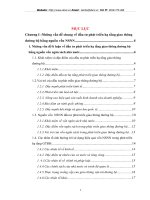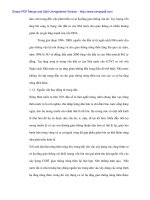Tóm tắt luận án Quản lý phát triển hạ tầng giao thông đường bộ Việt Nam theo hướng bền vững
Bạn đang xem bản rút gọn của tài liệu. Xem và tải ngay bản đầy đủ của tài liệu tại đây (836.88 KB, 52 trang )
BỘ GIÁO DỤC VÀ ĐÀO TẠO
MINISTRY OF EDUCATION & TRAINING
TRƯỜNG ĐẠI HỌC GIAO THÔNG VẬN TẢI
UNIVERSITY OF TRANSPORT AND COMMUNICATIONS
HOÀNG THANH TÚ
HOANG THANH TU
QUẢN LÝ PHÁT TRIỂN HẠ TẦNG
GIAO THÔNG ĐƯỜNG BỘ VIỆT NAM
THEO HƯỚNG BỀN VỮNG
SUSTAINABLE VIETNAM ROAD TRANSPORT
INFRASTRUCRTURE DEVELOPMENT
MANAGEMENT
(Tên cũ theo Quyết định: Tổ chức quản lý phát triển bền vững hạ tầng giao
thông đường bộ Việt Nam)
(Formerly under Decision: Organization of Sustainable Vietnam Road Transport
Infrastructure Development Management)
TÓM TẮT LUẬN ÁN TIẾN SĨ KINH TẾ
ABSTRACT OF ECONOMICS DOCTORAL
DISSERTATION
HÀ NỘI – 2015/ HANOI, 2015
The Dissertation was completed at the University of Transport and
Communications
Người hướng dẫn khoa học/Scientific instructor:
Phản biện/Reviewer 1:
………………………………………………………
………………………………………………………
Phản biện/Reviewer 2:
………………………………………………………
………………………………………………………
Phản biện/Reviewer 3:
………………………………………………………
………………………………………………………
Luận án sẽ được bảo vệ trước Hội đồng chấm luận án tiến sỹ cấp
Trường họp tại: Trường Đại học Giao thông vận tải.
Vào hồi: ….. giờ…. Ngày…. Tháng…..năm 2015.
The Dissertation will be defended to the Institution-Level Doctoral
Dissertation Reviewer Council
Place: University of Transport and Communications
Time: ....................., 2015......:..........
MỞ ĐẦU
INTRODUCTION
1. Giới thiệu về đề tài nghiên cứu/ Overview
Đề tài “Quản lý phát triển hạ tầng giao thông đường bộ Việt
Nam theo hướng bền vững” ngoài phần Mở đầu, Kết luận và các
Phụ lục có liên quan còn có 4 chương./ The study on “ Sustainable
Vietnam Road Transport Infrastructure Development Management”
consists of 4 Chapters, in addition to the Introduction, Conclusions
and Appendices.
2. Lý do chọn đề tài/ Rationale
Tìm ra các giải pháp về công tác quản lý nhằm tạo HTGTĐB
hiện đại, có chất lượng tốt, tuổi thọ cao, tiết kiệm chi phí hạn chế các tác
động tiêu cực đến môi trường, cũng như các tác động tiêu cực của môi
trường đến quá trình phát triển HTGTĐB…nhằm đáp ứng nhu cầu phát
triển KTXH, củng cố ANQP, hạn chế tác động tiêu cực đến môi
trường./ The reason for the study is to find management solutions to
create a modern, high-quality, long-life and economical road
transportation system with limited negative impacts on the environment
as well as negative environmental impacts on the road transport
infrastructure development, etc. to meet the needs of socio-economic
development, strengthen national defense and security and minimize
negative impacts on the environment.
3. Mục đích nghiên cứu của đề tài/ Objectives of the Study
- Hệ thống hóa, làm rõ và bổ sung cơ sở lý luận về quản lý phát
triển hạ tầng giao thông đường bộ Việt Nam theo hướng bền vững;/ To
codify, clarify and provide additional rationale for sustainable
Vietnam road transport infrastructure development management;
1
- Đánh giá thực trạng; đề xuất các giải pháp về quản lý …/ To
assess the current situation and make recommendations on
management solutions, etc.
4. Đối tượng và phạm vi nghiên cứu/Subjects &Scope of the
Study
Đối tượng nghiên cứu: Các vấn đề lý luận và thực tiễn.
Subjects of the study: Theoretical and practical matters.
Phạm vi nghiên cứu/Scope of the study:
- Về không gian: Vai trò cơ quan quản lý nhà nước để nghiên
cứu lý luận và thực tiễn của Việt Nam và kinh nghiệm của nước
ngoài;/ Space: Role of State management authoritiees to study the
theoretical and practical experiences of Vietnam and foreign countries;
- Về thời gian: Nghiên cứu thực trạng Việt Nam từ 2007 - 2013.
Giải pháp phục vụ mục tiêu đến năm 2020, tầm nhìn đến năm 2030./
Time: Study on actual situation of Vietnam from 2007 – 2013; solutions
for the goal by 2020, with a vision to 2030.
5. Ý nghĩa khoa học và thực tiễn của đề tài nghiên cứu/
Scientific and Practical Significance
- Ý nghĩa khoa học: Hệ thống hóa, làm rõ cở sở lý luận về quản
lý phát triển hạ tầng giao thông đường bộ theo hướng bền vững;/
Scientific significance: To codify and clarify rationale for sustainable
Vietnam road transport infrastructure development management;
- Ý nghĩa thực tiễn: Thực trạng từ 2007 đến 2013 và kinh nghiệm
của nước ngoài; Giải pháp đến năm 2025 và tầm nhìn đến 2035./
Practical significance: Actual situation of Vietnam and international
experiences from 2007 – 2013; solutions by 2025, with a vision to 2035.
2
CHƯƠNG 1
TỔNG QUAN CÁC CÔNG TRÌNH NGHIÊN CỨU VỀ
QUẢN LÝ PHÁT TRIỂN HẠ TẦNG GIAO THÔNG ĐƯỜNG BỘ
CHAPTER 1
OVERVIEW OF STUDIES ON ROAD TRANSPORT
INFRASTRUCTURE DEVELOPMENT MANAGEMENT
1.1. Phân tích đánh giá các công trình nghiên cứu ở trong và
ngoài nước liên quan đến quản lý phát triển hạ tầng giao thông
đường bộ / Analysis and Evaluation of Domestic and International
Research on Road Transport Infrastructure Development
1.1.1. Các công trình nghiên cứu của các tác giả trong nước/
Studies carried out by foreign authors
Đã đề cập đến 12 công trình của các tác giả trong nước/ There
have mentioned 12 studies of foreign authors.
1.1.2 Các công trình nghiên cứu ở nước ngoài/ Studies carried out
overseas
Đã đề cập đến 7 công trình của các tác giả ở nước ngoài/ There
have mentioned 7 studies carried out by authors abroad.
1.1.3 Nhận xét về các công trình nghiên cứu ở trong và ngoài nước
liên quan đến quản lý phát triển hạ tầng giao thông đường bộ/
Evaluation on Domestic and Foreign Research on Management of
Road Transport Development
1.1.3.1 Nhận xét chung / Overall Evaluation
Qua các công trình nghiên cứu trên đã/ The said studies have:
1. Cung cấp luận cứ khoa học để tác giả đưa ra phương hướng,
giải pháp về quản lý nhằm phát triển HTGTĐB theo hướng bền vững;/
provided the scientific foundation for the authors to propose
management directions and solutions to develop the road transport
3
system sustainably;
2. Đã giúp tác giả: đưa ra khái niệm và nội dung của quản lý
phát triển HTGTĐB theo hướng bền vững; thấy các bất cập, các vấn
đề cần tập trung nghiên cứu trong quản lý phát triển HTGTĐB;/
Helped the author introduce the concept and contents of sustainable
road transport infrastructure development management; and identify
the shortcomings and mattes to be focused on the management of road
transport system development;
3. Một số các: mục tiêu, quan điểm, định hướng, nguyên tắc, tiêu
chí, kinh nghiệm, mối quan tâm của các nhà khoa học đã được tác giả
tiếp thu, kế thừa và phát triển để xây dựng cơ sở lý luận./ Enable the
author to acquire, inherit and develop a number of objectives,
perspectives, orientations, principles, criteria, experience and
concerns of the scientists to establish a literature review.
1.1.3.2 Các vấn đề chưa nghiên cứu/ Matters to be further studies
Qua các công trình nghiên cứu trên, cho thấy/ The said studies
have also shown:
1. Chưa gắn kết với vấn đề củng cố an ninh quốc phòng;/ the
absence of security and defense consolidation involvement;
2. Chưa có công trình nghiên cứu: về quản lý phát triển hạ tầng
giao thông đường bộ ở Việt Nam theo hướng bền vững ở tất cả các
giai đoạn: dự báo, quy hoạch, đầu tư xây dựng và vận hành khai
thác./the lack of studies on sustainable road transport infrastructure
development management of Vietnam in all phases of forecasting,
planning, construction investment and operation.
1.1.4 Các vấn đề cần tiếp tục nghiên cứu/ Implications
Các vấn đề cần tập trung nghiên cứu, gồm/ The following are
implications for futher studies:
4
1. Về mục tiêu/ Objectives:
Ngoài các mục tiêu phát triển kinh tế, xã hội, bảo vệ môi
trường cần gắn với mục tiêu củng cố an ninh quốc phòng; hạn chế
các tác động tiêu cực của quá trình phát triển hạ tầng giao thông
đường bộ; cần có các giải pháp để nâng cao hiệu quả khai thác của
các tuyến giao thông hiện hữu; kết hợp xây dựng các tuyến giao
thông mới, phù hợp với nhu cầu sử dụng trong tương lai;/ In addition
to the goals of socio-economic development and environmental
protection, it should be linked with the aims of strengthening security
and defense; limiting the negative impacts of the road transport
infrastructure development; taking solutions to improve the effective
operation of the existing roads; and building new roads, in
accordance with the needs of use in the future;
2. Quản lý quy hoạch hạ tầng giao thông đường bộ cần: tích
hợp với vấn đề biến đổi khí hậu; gắn với các quy hoạch có liên
quan;/ The management of road transport infrastructure planning
should be integrated with climate change issues in association with
the relevant planning;
3. Quản lý ĐTXD cần tăng cường giám sát của cộng đồng,
gắn trách nhiệm và quyền lợi của các tổ chức cá nhân có liên quan;/
The construction investment management should have more public
supervision and ensure the responsibilities and rights of individuals
and organizations concerned;
4. Quản lý vận hành khai thác cần kết hợp nhiều giải pháp./
Multiple solutions should be combined in the operational
management.
1.2. Mục tiêu của đề tài nghiên cứu/ Objectives of the Study
1. Hệ thống hóa, xây dựng cơ sở lý luận về quản lý phát triển
5
hạ tầng giao thông đường bộ theo hướng bền vững;/ To codify and
provide rationale for the sustainable road transport infrastructure
development management;
2. Phân tích thực trạng quản lý phát triển HTGTĐB Việt
Nam;/ To analyze the current situation of Vietnam road transport
infrastructure development.
3. Đề xuất các giải pháp quản lý nhằm đáp ứng nhu cầu di chuyển
(nhanh, an toàn, tiết kiệm chi phí đi lại, phục vụ mục tiêu phát triển kinh
tế xã hội, góp phần bảo vệ môi trường, củng cố an ninh quốc phòng)/ To
propose management solutions to meet the needs of travelling (in a fast,
safe and cost-saving manner, serving the objectives of socio-economic
development and contributing to environmental protection and security
and defense consolidation)
1.3. Phương pháp nghiên cứu/ Methodology
- Phương pháp duy vật biện chứng, duy vật lịch sử; kết hợp
nghiên cứu định tính với nghiên cứu định lượng;/ Methods of
dialectical materialism and historical materialism; qualitative and
quantitative approaches;
- Cụ thể có các phương pháp như so sánh, đối chiếu, phân tích,
tổng hợp vấn đề và phương pháp chuyên gia; thu thập, xử lý thông
tin thứ cấp, phương pháp
tiếp cận hệ thống./Specifically, such
methods as comparison, analysis, syndissertation and expertise;
secondary data collection and processing and system approach.
6
CHƯƠNG 2
CƠ SƠ LÝ LUẬN VỀ QUẢN LÝ PHÁT TRIỂN
HẠ TẦNG GIAO THÔNG ĐƯỜNG BỘ THEO HƯỚNG BỀN VỮNG
CHAPTER 2
LITERATURE REVIEW ON MANAGEMENT OF
SUSTAINABLE ROAD TRANSPORT INFRASTRUCTURE
DEVELOPMENT
2.1. Phát triển hạ tầng giao thông đường bộ/ Road Transport
Infrastructure Development
2.1.1. Khái niệm về hạ tầng và phân loại hạ tầng/ Definition and
Classification of Infrastructure
2.1.2. Khái niệm về hạ tầng giao thông vận tải và hạ tầng giao
thông đường bộ/ Definitions of Transport Infrastructure and Road
Transport Infrastructure
2.1.3. Các đặc trưng của hạ tầng giao thông đường bộ/ Features of
Road Transport Infrastructure
Tính hệ thống; tính đồng bộ; tính tiên phong, định hướng; tính
công cộng; tính vùng; tính cố định, lâu dài, chi phí lớn./ Systematic,
synchronized, pioneering, oriented, public, regional, fixed, longlasting and high cost features.
2.1.4. Các yếu tố ảnh hưởng đến sự phát triển hạ tầng giao thông
đường bộ/ Influences on Road Transport Infrastructure
Bao gồm: Vị trí địa lý và điều kiện tự nhiên; Điều kiện kinh tế
xã hội; Cơ chế chính sách liên quan đến phát triển HTGTĐB./
Include geographic location and natural conditions; socio-economic
conditions and mechanisms and policies related to road transport
infrastructure development.
2.1.5. Tác động của phát triển hạ tầng giao thông đường bộ đến
7
kinh tế xã hội, môi trường và an ninh quốc phòng/ Socioeconomic, Environmental, Security and Defense Effects of Road
Transport Infrastructure Development
Có tác động trực tiếp và gián tiếp; tích cực và tiêu cực; ngắn
hạn, trung hạn và dài hạn; hữu hình và vô hình; mạnh và yếu./ There
are direct and indirect; positive and negative; short-medium and
long term; tangible and intangible & strong and weak effects.
Khi xem xét tác động của HTGTĐB cần xem xét các tác động
đến KTXH; môi trường, sức khỏe của người dân; ANQP. Cùng đối
tượng và quy mô của các tác động về mặt không gian và thời gian./
With regards to effects of road transport infrastructure, it is required
to consider effects on the economy, society, environment, human
health, security and defense in association with the objects and scope
of these effects in terms of both space and time.
Làm cạn kiệt TNTN; tạo ra sự thiếu công bằng giữa các đối
tượng khi tham gia giao thông; tạo gánh nặng cho nền kinh tế; tác
động xấu đến cơ cấu sử dụng đất, môi trường sinh thái, mất
ANLT;.../ Some effects are depletion of natural resources; inequity
for traffic participants; burdens for the economy and adverse
impacts on land use structure, ecology and food security losses, etc.
2.2. Phát triển và quản lý phát triển hạ tầng giao thông đường bộ
theo hướng bền vững/ Development and Sustainable Road
Transport Infrastrucre Development Management
2.2.1. Khái niệm phát triển hạ tầng giao thông đường bộ theo
hướng bền vững/ Definition of Sustainable Road Transport
Infrastructure Development
“Phát triển hạ tầng giao thông đường bộ theo hướng bền vững là
phát triển một cách hài hoà, đồng bộ liên thông, đảm bảo đáp ứng nhu
8
cầu và lợi ích sử dụng hiện tại, có tính đến sự gia tăng và mức độ phù
hợp của nhu cầu và lợi ích sử dụng trong tương lai được an toàn, công
bằng và tốt nhất góp phần phát triển kinh tế - xã hội – bảo vệ môi
trường – củng cố an ninh quốc phòng”. / “Sustainable road transport
infrastructure development is to develop it in a harmonized and
synchronous way, ensuring to meet current use needs and interests,
taking into account the rise and relevance of the fairest, safest and
best future use needs and interests, contributing to the socio-economic
development - environmental protection and security and defense
consolidation."
Muốn vậy, cần có quy hoạch, có chiến lược ổn định lâu dài./
To do so, it is necessary to make planning and stable and long-term
strategies.
2.2.2. Các nguyên tắc phát triển hạ tầng giao thông đường bộ theo
hướng bền vững/ Principles of Sustainable Road Transport
Infrastructure Development
Gồm có: bảo vệ môi trường; phát huy vai trò quản lý của cộng
đồng; công bằng và hiệu quả kinh tế; hiệu quả xã hội; đi trước, có
chiến lược lâu dài với tầm nhìn dài hạn; đồng bộ/ The principles
include protecting the environmental; promoting the role of public
management; ensuring fairness and socio-economic efficiency;
pioneering, having long term strategies with a long-term vision; and
ensuring synchronization.
Cuối cùng là nguyên tắc quy hoạch HTGTĐB gắn với các quy
hoạch khác và công tác dự báo cần theo trình tự sau: Môi trường =>
Vùng sử dụng đất => Các đường cao tốc, các tuyến quốc lộ => Tổng
thể phát triển KTXH => Phân khu chức năng trong vùng sử dụng đất
=> Quy hoạch giao thông, trong vùng sử dụng đất./ Finally, the
9
planning of road transport infrastructure should be associated with
other planning and the forecasting needs in the following order:
Environment => Land use areas => expressways & national roads
=> Overall socio-economic development => functional division of
land use areas => transport planning in land use areas.
2.2.3. Các tiêu chí đánh giá sự phát triển hạ tầng giao thông
đường bộ theo hướng bền vững/ Criteria for Assessment of
Sustainable Road Transport Infrastructure Development
Tiêu chí về kinh tế gồm 5 chỉ tiêu: chi phí và thời gian vận
chuyển; giá trị của đất; tốc độ tăng trưởng kinh tế; thu chi của ngân
sách/ Economic criteria include 5 criteria of cost and transportation
time; land value; economic growth; budget revenue and expenditure
Tiêu chí về xã hội gồm 2 chỉ tiêu: ATGT; khả năng tiếp cận/
Social criteria include two indicators of traffic safety and access
Tiêu chí về môi trường gồm chỉ tiêu về: môi trường không khí
và tiếng ồn; liên quan đến hệ sinh thái/ Environmental criteria
include air environment and noise indicator and ecosystem related
indicator.
2.2.4. Khái niệm, nội dung quản lý phát triển hạ tầng giao thông
đường bộ theo hướng bền vững/ Definition and Contents of
Management of Sustainable Road Transport Infrastructure
Development
2.2.4.1 Quản lý dự báo phát triển hạ tầng giao thông đường bộ/
Management of Forecasts on Road Transport
Infrastructure
Development
Bao gồm quản lý: công tác khảo sát thống kê; công tác phân
tích đánh giá các dự báo; phân tích các số liệu dự báo và các chính sách;
quy trình dự báo; phương pháp và lựa chọn phương pháp dự báo./ This
10
includes the management of statistical survey; forcast analysis and
evaluation; forecast data and policy analysis; forecasting processes;
forecasting methods and selection.
2.2.4.2 Quản lý quy hoạch phát triển hạ tầng giao thông đường bộ/
Management of Planning of Road Transport Infrastructure
Development
Theo truyền thống nhằm mục đích cải thiện HTGTĐB để đáp
ứng nhu cầu đi lại của các phương tiện giao thông/ Traditionally, it
aims at improving the road transport infrastructure to meet the
travelling needs of vehicles.
Theo hướng bền vững sẽ: tập trung vào việc di chuyển của
người, hàng hóa hơn là việc di chuyển của PTGT nhằm đạt được sự di
chuyển cao nhất với lưu lượng, mật độ của các PTGT thấp nhất; giảm
thiểu các tác động tiêu cực; góp phần định hướng cho QHXD và đưa
ra các nguyên tắc quy hoạch HTGTĐB theo hướng bền vững gồm: 07
nguyên tắc về quy hoạch HTGTĐB; 03 nguyên tắc quy hoạch giao
thông đô thị; 06 nguyên tắc quy hoạch HTGTĐB trong các đô thị./
Towards sustainability, it will focus more on the movement of people
and goods than that of vehicles to achieve the highest transporation
with the thinnest density of vehicles, minimizing negative impacts;
contributing to orienting the construction planning and making the
sustainable road transport infrastructure planning principles,
including: 07 road transport infrastructure principles, 03 urban
transport planning ones; 06 urban road transport infrastructure
planning ones.
2.2.4.3. Quản lý đầu tư xây dựng hạ tầng giao thông đường bộ/
Management of Investment in Construction of Road Transport
Infrastructure
11
Mục tiêu: Về tổng thể để hiện thực hóa các quy hoạch đã thiết
lập trước đó; Tạo ra được công trình có chất lượng tốt, đáp ứng các
tiêu chuẩn kỹ thuật theo thiết kế, tiết kiệm chi phí …./Objectives: In
general, it is to realize the set-out planning and create good quality
structures, meeting technical design standards with the lowest costs,
etc.
2.2.4.4. Quản lý vận hành khai thác hạ tầng giao thông đường bộ/
Management of operation of road transport infrastructure
Là các hoạt động có mục đích nhằm khai thông và duy trì năng
lực thông qua của các tuyến đường và các công trình phụ trợ phục vụ
cho việc di chuyển của người và hàng hóa theo đúng thiết kế. / As the
operation is intended to inform and sustain implementation capacity
through the routes and the ancillary works to serve the mobility of
people and goods in accordance with design.
2.2.5. Các yếu tố ảnh hưởng đến quản lý phát triển hạ tầng giao
thông đường bộ theo hướng bền vững/ Influences on
Manangement of Sustainable Road Transport Infrastructure
Development
- Do công tác dự báo có 11 yếu tố gồm: Trình độ của người làm
công tác dự báo; Thời gian cần dự báo; Quy mô, phạm vi khảo sát;
Các số liệu, tài liệu thu thập được; Các chỉ tiêu cần dự báo …./ The
forecasting includes 11 factors of forecasters’ qualifications; Time to
be forecasted; Size and scope of surveys; data and documents
collected and criteria to be forecasted, etc..
- Do công tác quy hoạch có 10 yếu tố ảnh hưởng gồm: Vị trí địa
lý, điều kiện tự nhiên; Trình độ khoa học kỹ thuật, phương pháp, chất
lượng công tác khảo sát; Tiềm năng và tốc độ phát triển kinh tế; Đánh
giá nhu cầu hiện tại và dự báo nhu cầu giao thông trong tương lai; …/
12
The planning has 10 influences, including geographical location &
natural conditions; Scientific and technical levels, methods and quality
of surveys; economic potential and growth; assessment on current
traffic needs and forecasts on future demands, etc.
- Do công tác đầu tư xây dựng có 9 yếu tố gồm: Vi trí địa lý,
địa hình, thời tiết khí hậu; khả năng cung ứng vật tư thiết bị; Công
tác chuẩn bị; Tình hình kinh tế; Cơ cấu tổ chức; trình độ chuyên
môn, phẩm chất đạo đức của các cá nhân có liên quan; …/The
construction investment involves in 9 factors of geographic location,
topography, climate and weather; availability of materials and
equipment; preparation; economic status; organizational structure;
professional qualifications, moral qualities of individuals concerned;
etc.
- Do công tác quản lý vận hành khai thác có 9 yếu tố gồm: Sự
phù hợp của phương án quy hoạch; chất lượng ĐTXD; Mức độ chi tiết
của các yêu cầu đặt ra; Sự tác động của vị trí địa lý, thời tiết khí hậu; …/
The operation management includes 9 factors of the appropriateness of
planning options;
construction investment
quality;
details
of
requirements; impacts of geographic location, climate and weather;
etc..
2.2.6. Các tiêu chí đánh giá công tác quản lý phát triển hạ tầng
giao thông đường bộ theo hướng bền vững/ The criteria for
evaluating the management of the infrastructure development of
road transport towards sustainability
2.2.6.1. Tiêu chí về sự phù hợp/ Compatibility criteria
Đặt ra 04 yêu cầu và các nhóm chỉ tiêu: Về sử dụng PTGT công
cộng ở các đô thị; Về chất lượng cơ sở hạ tầng giao thông ở các đô thị;
Về chất lượng đường quốc lộ; Về vốn bảo trì; Về ý thức của người
13
tham gia giao thông; Về mật độ các phương tiện tham gia giao thông; /
It sets out 04 requirements and indicator groups of urban public
transport use; quality of urban transport infrastructure; quality of
national roads; maintenance funds; awareness of traffic participants;
and density of traffic vehicles;
2.2.6.2 Tiêu chí về kết nối/ Connection criteria
Đặt ra 02 yêu cầu và 06 chỉ tiêu cơ bản về kết nối/ It provides
02 basic requirements and 06 criteria on connection
2.2.6.3. Tiêu chí về hiệu quả kinh tế/ Economic Performance Criteria
Đặt ra 03 yêu cầu và 04 chỉ tiêu cơ bản về hiệu quả kinh tế./ It
sets out 03 basic requirement and 04 criteria on ecconomic
performance.
2.2.6.4. Tiêu chí về các tác động/ Impact Criteria
Đặt ra 03 yêu cầu và 04 chỉ tiêu cơ bản về các tac động./ It sets
out 03 basic requirements and 04 criteria on impacts.
2.2.6.5. Tiêu chí về tính bền vững/ Sustainability Criteria
Tiêu chí này đặt ra các yêu cầu và các điều kiện (ổn định chính
trị và đồng thuận của các tầng lớp nhân dân; Nguồn tài chính; nguồn
nguyên vật liệu; quỹ đất phục vụ phát triển HTGTĐB; Khả năng đáp
ứng và nhu cầu sử dụng GTĐB) để duy trì sự tồn tại và phát triển của
các công trình về HTGTĐB; cùng 04 nhóm chỉ tiêu về tính bền
vững/ It sets out the requirements and the conditions (on political
stability and consensus among all classes of people; financial
resources; material resources; land fund for road transport
infrastructure development; ability to meet needs of road transport
use) to maintain and develop road transport infrastructure; and 04
groups of sustainability indicators
2.2.7. Kinh nghiệm của một số nước về công tác quản lý phát triển
14
hạ tầng giao thông đường bộ/ Experiences of Some Countries on
Management of Road Transport Infrastructure Development
Công khai minh bạch; có tầm nhìn dài hạn, xây dựng các tuyến
giao thông chính để định hướng cho các tuyến giao thông phụ; tập
trung vào quản lý nhu cầu giao thông, giáo dục ý thức khi tham gia
giao thông …. Tuy nhiên, chưa có kinh nghiệm của nước nào thực sự
góp phần quản lý phát triển HTGTĐB theo hướng bền vững./ Some
experiences are transparency; long-term vision, major roads aiming to
direct auxiliary ones; focus on traffic demand management and
education on traffic participation awareness, etc. However, none of
them has actually contributed to the management of sustainable road
transport infrastructure development.
Do đó, quản lý phát triển HTGTĐB theo hướng bền vững cần/
Therefore,
the
management
of
sustainable
road
transport
infrastructure development should:
1. Về mục tiêu: GTĐB hiện đại, đáp ứng nhu cầu đi lại nhanh và
an toàn chính là động lực để phát triển, góp phần tăng thu cho ngân
sách, tạo điều kiện thuận lợi về tài chính để phát triển HTGTĐB;/ With
regard to objectives: ensure the modern road transport, meeting the
needs of fast and safe travel which is the drive for development,
contributing to increased budget revenues and financially facilitating
the road transport infrastructure;
2. Về quản lý quy hoạch: Cần có tầm nhìn dài hạn với các trục
giao thông chính mang tính định hướng; Cần có một cơ quan chuyên
trách, làm đầu mối quản lý quy hoạch HTGTĐB;/ With regard to
planning: have a long-term vision with oriented main roads and a
specialized agency to act as a focal point in managing road
transport infrastructure planning;
15
3. Về quản lý đầu tư xây dựng: Cần có chính sách huy động từ
nhiều nguồn khác nhau, đặc biệt nguồn vốn của tư nhân;/ With
regard to management of construction investment: propose policies
mobilized from various sources, particularly private funding;
4. Về quản lý vận hành khai thác: Hạn chế nhu cầu sử dụng
PTGT cá nhân bằng cơ giới, khuyến khích sử dụng PTGT công cộng./
With regard to operation management: Limit personal motored vehicle
use needs and encourage public vehicle use.
Kết luận Chương 2/ Conclusions of Chapter 2
- Đưa ra khái niệm, các đặc trưng, các yếu tố ảnh hưởng đến phát
triển HTGTĐB; cùng các tác động ngược lại của phát triển HTGTĐB;/
Concepts and features of and influences on road transport
infrastructure development along with its opposite effects;
- Đưa ra khái niệm, bảy nguyên tắc và sáu tiêu chí về phát
triển hạ tầng giao thông đường bộ theo hướng bền vững;/ Concepts,
seven principles and six criteria concerning sustainable road transport
infrastructure development;
- Đưa ra khái niệm, trình bày nội dung, các yếu tố ảnh hưởng,
các tiêu chí (cùng các yêu cầu và các chỉ tiêu) đánh giá công tác quản
lý phát triển HTGTĐB theo hướng bền vững ở cả bốn giai đoạn;/
Concepts and contents of and influences on and criteria (with
requirements and indicators) for evaluating the management of
sustainable road transport infrastructure development in all four stages;
- Nghiên cứu, tổng kết kinh nghiệm của một số nước để rút ra bài
học cho Việt Nam về quản lý phát triển hạ tầng giao thông đường bộ./
Lessons from some countries on management of road transport
infrastructure development for Vietnam.
16
CHƯƠNG 3
PHÂN TÍCH ĐÁNH GIÁ THỰC TRẠNG QUẢN LÝ
PHÁT TRIỂN HẠ TẦNG GIAO THÔNG ĐƯỜNG BỘ VIỆT NAM
CHAPTER 3
ANALYSIS & ASSESSMENT OF CURRENT SITUATION OF
VIETNAM ROAD TRANSPORT INFRASTRUCTURE
DEVELOPMENT MANAGEMENT
3.1 Thực trạng quản lý phát triển hạ tầng giao thông đường bộ
Việt Nam từ năm 2007 đến năm 2013/ Management of Vietnam
road transport infrastructure development from 2007 to 2013
3.1.1. Công tác lập và quản lý quy hoạch phát triển hạ tầng giao
thông đường bộ Việt Nam/ Preparation and management of
Vietnam road transport infrastructure development planning
Chưa đáp ứng yêu cầu (đặc biệt ở các đô thị lớn), bị chồng
chéo, thiếu đồng bộ, chưa gắn kết với nhau, gây lãng phí, thời gian
quy hoạch thường ngắn, thường xuyên thay đổi, điều chỉnh, chưa có
đầu mối quản lý chính. Ảnh hưởng đến đảm bảo ANLT (do bị mất
diện tích đất nông nghiệp). Công tác đền bù GPMB gặp khó khăn./
This planning does not meet the requirements (especially in large
urban areas), shows an overlapping relationship, lacks uniformity
and combination, causes waste, has short period of planning time,
makes continuous change and adjustment, and has no key
management unit. What is more, it affects food security issue (due to
loss of agricultural land) and shows difficulties in land clearance
compensation.
3.1.2. Công tác quản lý đầu tư xây dựng hạ tầng giao thông
đường bộ/ Road transport infrastructure construction investment
17
management
Tỷ lệ vốn đầu tư so với GDP cao hơn các nước khác, nhưng
không hiệu quả (tất cả các chỉ số đều ở vị trí cuối của bảng xếp
hạng), chỉ số ICOR gần gấp đôi so với các nước trong khu vực./ The
investment-to-GDP ratio is higher than that of other countries, but
the investment turns out to be inefficient (all indexes appear on the
lowest rank positions), ICOR almost doubles that of other countries
in the region.
Chất lượng HTGTĐB có thể khái quát qua các biểu đồ sau/
Quality of road transport infrastructure is shown in the following pie
charts
Biểu đồ/Chart No. 3.8: Tỷ lệ các loại đường ở Việt
Nam/Percentage of types of Vietnam’s roads
(Nguồn: Tác giả tổng hợp và từ [72])
(Source: data collected by the author and from [72])
18
Biểu đồ/Chart No. 3.9: Chất lượng đường ở Việt Nam/Vietnam’s
road quality
(Nguồn: Tác giả tổng hợp và từ [72])
(Source: data collected by the author and from [72])
Biểu đồ 3.10: Kết cấu mặt đường ở Việt Nam
(Nn: Tác giả tổng hợp và từ [72])
Pie chart 3.10: Vietnam’s road surface structure
(Source: data collected by the author and from [72])
Các chỉ tiêu về chất lượng HTGTĐB (nhằm phát triển theo
hướng bền vững) đạt rất thấp với các chỉ tiêu đặt ra ở Chương 2. /
The indicators of road transport infrastructure quality reached
19
(toward sustainable development) are very low compared with those
set out in Chapter 2.
Dẫn đến chi phí vận chuyển và xuất khẩu cao, làm giảm khả
năng canh tranh của Việt Nam (xem biểu đồ 3.12 và Bảng 3.5)./ This
consequently leads to an increase in transportation & export costs,
and a decrease in competition ability of Vietnam (see pie chart 3.12
and Table 3.5).
Chưa mang tính hệ thống, việc phân cấp chưa rõ ràng, bị chồng
chéo, chưa có cơ quan độc lập; chưa quan tâm đúng mức đến quản lý
chất lượng đối với các dự án do các quận, huyện, thị làm chủ đầu tư./
There have not been a systematic management, clear decentralization
which still has overlapping functions, and an independent management
body; additionally, there has been a lack of adequate attention to
management of quality of projects owned by districts and towns as
employers.
3.1.3. Công tác quản lý khai thác sử dụng hạ tầng giao thông
đường bộ/ Road transport infrastructure operation management
Vốn bảo trì: quốc lộ mới đáp ứng được khoảng 55% nhu cầu;
đường giao thông địa phương khoảng 20 đến 30% nhu cầu; đường
GTNT hầu như không có, năm 2013 cũng chỉ đạt 15%./ Maintenance
funding meets about 55% of demand with respect to new national
roads; about 20% to 30% - local roads; and almost no funding for
rural roads, (only 15% in 2013).
20
Biểu đồ/Chart No. 3.12 : Các trụ cột của năng lực cạnh tranh của Việt
Nam/advantages of competitiveness of Vietnam
(Nguồn: The Global Competitiveness Report 2013 – 2014)
(Source: The Global Competitiveness Report 2013-2014)
Hệ thống khung tiêu chuẩn, định mức còn thiếu, chưa đồng bộ.
Mất cân đối giữa vốn ĐTXD cơ bản (từ 88-94%) và vốn bảo trì (từ 612%); nên nhiều hạng mục sửa chữa không được thực hiện [73,
tr.23]./ There has been a lack of standard and synchronic framework
system. Besides, the imbalance between basic construction investment
fund (88-94%) and maintenance fund (6-12%) leads to the failure to
implement lots of repair items [73, p.23].
TNGT nhiều so với các nước khác (xem biểu đồ 3.13 và 3.14],
ngày càng gia tăng trên các tuyến quốc lộ. Do ý thức của người tham
gia giao thông; giao thông hỗn hợp; chất lượng HTGTĐB kém./
21
Traffic accident rate being higher than that in other countries (see
the pie charts 3.13 and 3.14] has increased on national roads due to
drivers’ noncompliance with traffic laws, complex traffic situations,
and poor quality of road transport infrastructure.
UTGT ngày càng trở nên trầm trọng trong các đô thị lớn Chưa
có giải pháp hữu hiệu. Nguyên nhân: chủ yếu là do TNGT (chiếm
44%), do lưu lượng PTGT đông (chiếm 23%) [5], PTGT cộng cộng
chỉ đáp ứng khoảng 10% nhu cầu. Ngoài ra do: mật độ phương tiện,
mật độ dân số, cơ cấu phương tiện bất hợp lý, hạ tầng lạc hậu …/
Traffic congestion appears to be more serious in large urban areas
without being resolved with effective solutions. The issue is caused
mainly by traffic accidents (44%), and large number of vehicles
(23%) [5]; meanwhile, means of public transport can only meet
about 10% of demand. In addition, other causes include high density
of vehicles & population, irrational structure of vehicles, backward
infrastructure, etc.
3.1.4. Đánh giá tác động của phát triển hạ tầng giao thông đường
bộ đối với môi trường, sức khỏe con người/ Assessing impacts of
road transport infrastructure development on environment and
human health
GTVT là ngành tiêu thụ xăng dầu nhiều nhất (chiếm 55%) [11]
và nhu cầu ngày càng cao - xem Biểu đồ 3.23 và 3.24./ Transport
sector is the largest consumer of fuel (accounting for 55%) [11] with
increasing demand - see Charts 3.23 and 3.24.
ÔNMT luôn vượt tiêu chuẩn cho phép, chủ yếu do các PTGT
gây ra. Chất lượng không khí đứng thứ 123/132; ảnh hưởng của môi
trường đến sức khỏe của người dân đứng thứ 77/132 trên thế giới./
Environmental pollution always exceeds permissible limit, mainly
22
caused by means of transport on roads. Air quality ranks 123th
among 132 countries in the world; and environmental impact on
human health – 77th among 132 countries.
Hoạt động GTVT là một trong những nguyên nhân chính gây
ÔNMT. Nghiên cứu cho thấy 80% bệnh tật của con người do ÔNMT/
Transport activity is one of the main causes of environmental
pollution. Research shows that, 80% of human diseases results from
environmental pollution.
3.1.5. Đánh giá tác động của môi trường đối với hạ tầng giao
thông đường bộ/ Assessing environmental impacts on road
transport infrastructure
Hàng năm: Thiệt hại do thiên tai gây ra từ 1,2% đến 2% GDP;
Đường giao thông cơ giới bị hỏng do thiên tai bình quân khoảng hơn
1.000 Km. Chi phí đảm bảo giao thông phải chi hàng trăm tỷ đồng./
Annually, damage caused by natural disasters makes up for 1.2% to
2% of GDP; about more than 1,000 Km of roads for motor vehicles
are damaged by natural disasters on average. Hundreds of billions
of dongs have been annually spent on costs of transport assurance.
Tình trạng ÔNMT ngày càng trầm trọng gây tác động xấu. / The
increasing environmental pollution has negative effects.
Mưa bão, lốc, lũ quét ngày càng bất thường (xem biểu đồ 3.25
[14, tr.39] và liên tục gia tăng (xem biểu đồ 3.26 [14, tr.39] (xem biểu
đồ 3.27 [14, tr.40] gây hại đến chất lượng và tuổi thọ HTGTĐB./
Rainstorm, tornado, and flash flood conditions seem to have become
more severe (see chart 3.25 [14, p.39] and constantly increasing (see
chart 3.26 [14, p.39] (see chart 3.27 [14, p.40] causing harm to the
quality and useful life of road transport infrastructure.
Xu hướng, nhiều vùng đất, nhiều tuyến đường giao thông ở
23









